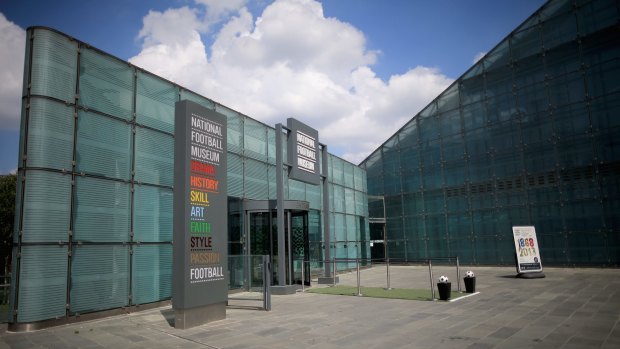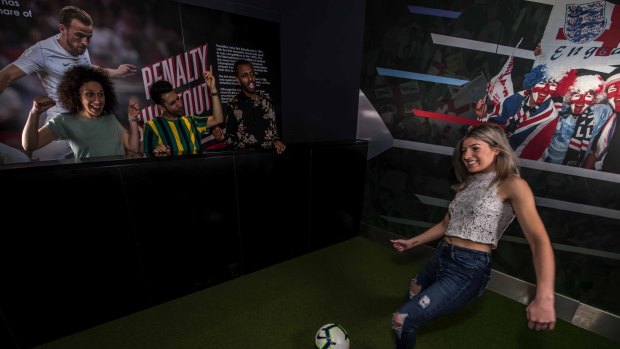This was published 1 year ago
National Football Museum, Manchester UK: A fitting tribute to 'the beautiful game'
By Steve Meacham

The National Football Museum is an essential visit for anyone who loves "the beautiful game". Credit: Christopher Furlong
As you walk into Britain's National Football Museum, you can't help noticing George Best's last Mini. It's immaculate, unblemished. Mainly because Best - the Messi or Ronaldo of his time - was banned for drink driving.
Best, the only soccer star ever to have a hit record about him ("Belfast Boy"), repeatedly told a story on chat shows about winning a fortune at Las Vegas's gambling tables, strewing the money over the bed while his then girlfriend, Miss World Mary Stavin, got dressed in a negligee.
According to the late Best, the Manchester United fan who delivered the bottles of champagne Best had ordered ignored the swad of dollar notes on the bed and his companion and said: "Georgie … where did it all go so terribly wrong?"

Visitors can try their hand (or foot, as it were) at scoring during a penalty shoot out.
This might have been a figment of Best's alcoholic imagination because Stavin is on record as saying she's never worn a negligee in her life.
Best quit United - and football for the first time - in 1974 at the peak of his powers.
The museum's tribute to the late Sir Matt Busby quotes the tactical instructions he gave to a team including the likes of Sir Bobby Charlton and Denis Law (there's a statue to "the Trinity" outside Old Trafford, United's ground).
"My team talks were easy," Busby said. "As soon as you receive the ball pass it to George Best."
Busby, Best, Charlton and Law are all now honoured in the museum's Hall of Fame.
Sadly Best, playing for Northern Ireland, was the greatest player to never play in the World Cup finals - about to start, controversially, in Qatar on November 20.
This museum - originally based at Preston North End's ground (Preston was a founder club of the Football League, the forerunner of the Premier League) - now occupies a prime spot in Manchester's central entertainment quarter.
Its architecture duplicates that of modern football terraces - and is an essential visit for anyone who loves "the beautiful game".
Naturally it focuses on the British contribution to the most popular sport in the world, from Highland skirmishes between the English and the Scots, balls made out of pigs bladder, and the writing of the Football Association rules (before VAR was ever invented).
However its four floors of exhibitions pay due diligence to the growth of the women's game, the importance of community and children's sport, and the pleasure disabled people get from playing with their teammates every weekend during the season.
The line that struck a goal from me was a quote from Ruud Guillit, the Dutch master who (naturally) is honoured in the Hall of Fame, along with Pele, Eusebio, Johan Cruyff, Eric Cantona, Maradona, Jimmy Greaves, Zine Zidane et al.
"If I had wanted to be an individual star, I'd have taken up tennis," said Gullitt (who captained the Netherlands to their first UEFA Euro in 1988 and two European cup final victories for AC Milan).
Until recently you would have been able to see the most infamous jersey ever worn in World Cup history.
In the 1986 quarter final against England - when memories of the Falklands/Malvinas war were still raw - Maradona cheated to score the "Hand of God" goal, punching the ball over the much taller frame of goalkeeper Peter Shilton.
Minutes later Maradona scored a brilliant, legitimate second, commonly known as "the goal of the century".
After the match, Maradona swapped the jersey with little known midfielder Steve Hodge, who lent it to the museum for 20 years.
However in May (2022) it was sold at auction for $12.4 million, a world record price for sporting memorabilia. Which just goes to show how valuable so many of these exhibits are.
Personal highlights include Pele's World Cup medal from his 1962 Chile campaign, after already winning one as a 17-year-old in Stockholm in 1958 (and securing a third in Mexico ,1970): still the only player to have won three World Cup Medals.
There's a figurine from the 1890s of "a girl footballer" and a section devoted to Lilian Parr - the forerunner of contemporary female stars like Sam Kerr.
Plus Geoff Hurst's shirt while he scored the only hat-trick in World Cup history.
THE DETAILS
FLY
Qatar, Etihad, Singapore and British Airways all have flights to Manchester Airport.
VISIT
Open seven days a week, the National Football Museum is a five-minute walk from Manchester Piccadilly, the city's rail terminus. Adults £12, Children £7 ($21/$12). See: nationalfootballmuseum.com
Sign up for the Traveller Deals newsletter
Get exclusive travel deals delivered straight to your inbox. Sign up now.